
Boronia clavata, commonly known as Bremer boronia, is a plant in the citrus family, Rutaceae and is endemic to the south-west of Western Australia. It is a shrub with bipinnate leaves and pale, yellowish green, four-petalled flowers.
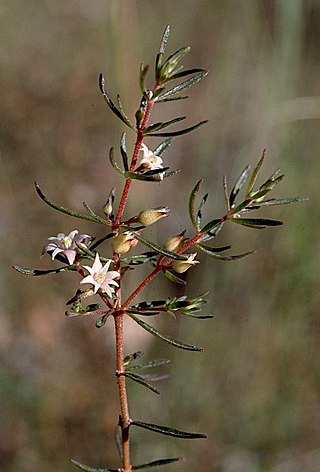
Boronia jucunda is a plant in the citrus family Rutaceae and is endemic to the far north-west of Australia. It is an erect shrub with many branches, pinnate leaves and white, four-petalled flowers. It is only known from a small area in the Kimberley region in Western Australia and in a national park in the Northern Territory.

Boronia juncea is a plant in the citrus family, Rutaceae and is endemic to the far south-west of Western Australia. It is an erect shrub with linear, short-lived leaves and groups of up to eight white to pink, four-petalled flowers.

Boronia octandra is a plant in the citrus family, Rutaceae and is endemic to the south-west of Western Australia. It is a small shrub with three-part leaves and greenish cream to reddish brown, four-petalled flowers.
Cyanothamnus acanthocladus is a plant in the citrus family, Rutaceae and is endemic to a small area in the south-west of Western Australia. It is a low, prickly shrub with small leaves and white, four-petalled flowers.
Boronia barrettiorum is a plant in the citrus family Rutaceae and is only known from two populations growing north of the Prince Regent River in the Kimberley Australia region of Western Australia. It is an erect, open shrub with hairy branches and leaves, simple or trifoliate leaves and white, four-petalled flowers.
Boronia coriacea is a plant in the citrus family, Rutaceae and is endemic to a small area in the south-west of Western Australia. It is a small shrub with pinnate leaves and hairless pink, four-petalled flowers in small clusters on the ends of the branches.

Cyanothamnus defoliatus is a plant in the citrus family, Rutaceae and is endemic to the south-west of Western Australia. It is a straggly shrub with simple, thread-like leaves and white to pink, four-petalled flowers that are pale blue on the back.

Boronia dichotoma is a plant in the citrus family, Rutaceae and is endemic to the south-west of Western Australia. It is an erect, slender perennial herb or shrub with simple leaves and pink, four-petalled flowers. The species is characterised by sticky glandular hairs on the pedicels.
Boronia interrex, commonly known as the Regent River boronia, is a plant in the citrus family, Rutaceae and is endemic to a small area in the Kimberley region of Western Australia. It is an erect, sometimes low-lying shrub with pinnate leaves, cream-coloured to pale pink sepals and pink petals, the sepals longer and wider than the petals.
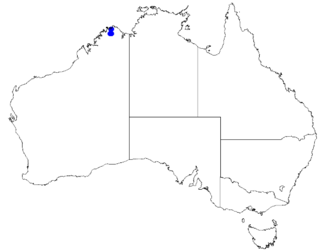
Boronia kalumburuensis is a plant in the citrus family Rutaceae and is endemic to the Kalumburu area of Western Australia. It is an erect or sprawling shrub with many branches, pinnate leaves and white to pink four-petalled flowers with the sepals longer and wider than the petals.
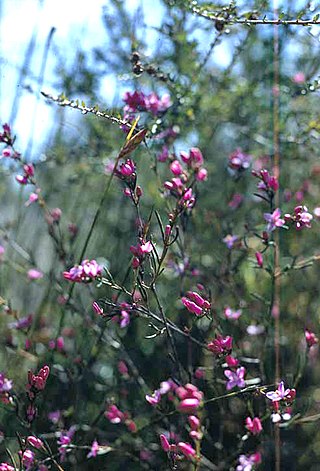
Boronia nematophylla is a plant in the citrus family Rutaceae and is endemic to the south-west of Western Australia. It is a shrub with thin, simple leaves and pale red to purple, four-petalled flowers arranged singly or in small groups in leaf axils.
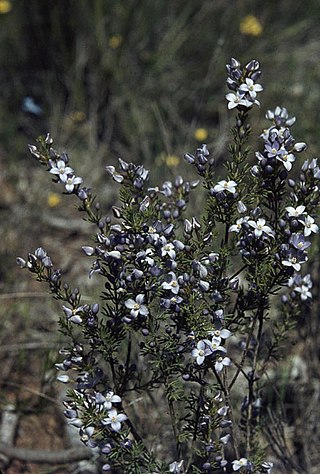
Cyanothamnus ramosus is a species of plant in the citrus family Rutaceae and is endemic to the southwest of Western Australia. It is an erect, mostly glabrous shrub with pinnate leaves with up to seven leaflets, and white, four-petalled flowers with blue or pale green backs.
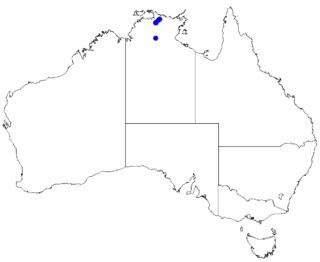
Boronia rupicola is a species of plant in the citrus family Rutaceae and is endemic to a small area in the Northern Territory, Australia. It is a small shrub with weeping branches, simple or pinnate leaves and small, green, inconspicuous flowers.
Boronia tetragona is a species of plant in the citrus family, Rutaceae, and is endemic to a small area of the southwest of Western Australia. It is an erect, glabrous, perennial herb with simple, sessile leaves and pink, four-petalled flowers.
Boronia thedae, commonly known as the Theda boronia, is a plant in the citrus family, Rutaceae and is endemic to a small area in the Kimberley region of Western Australia. It is an erect shrub when young, later a prostrate shrub with many branches, pinnate leaves, four white to cream-coloured or pale pink sepals and four similarly coloured petals, the sepals longer and wider than the petals.

Boronia tolerans is a plant in the citrus family, Rutaceae and is endemic to a small area in the Northern Territory in Australia. It is an erect shrub with many branches, pinnate leaves and white, four-petalled flowers. It is only known from Nitmiluk National Park.
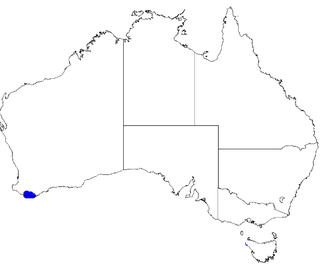
Boronia virgata is a plant in the citrus family, Rutaceae and is endemic to the south coast of Western Australia. It is a virgate shrub with pinnate leaves with between three and five leaflets, and flowers with red sepals and deep pink, egg-shaped petals.

Cyanothamnus westringioides is a species of erect shrub that is endemic to a small area in the southwest of Western Australia. It has simple, narrow, sessile leaves and pale pink flowers arranged singly in leaf axils.
Philotheca nutans is a species of flowering plant in the family Rutaceae and is endemic to the south-west of Western Australia. It is a small, densely-branched shrub with club-shaped to cylindrical, glandular-warty leaves and pendent, pale yellow to pale red flowers arranged singly in leaf axils.













